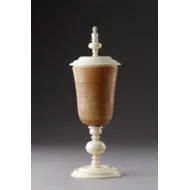German Renaissance Turned Rhinoceros Horn and Ivory Cup and Cover
A German Renaissance Turned Rhinoceros Horn and Ivory Cup and Cover
Smooth silky patina
An old beetle hole to one side of cup
Early 17th Century
Size: 25cm high, 8.5cm dia. - 9¾ ins high, 3¼ dia.
Smooth silky patina
An old beetle hole to one side of cup
Early 17th Century
Size: 25cm high, 8.5cm dia. - 9¾ ins high, 3¼ dia.
A German Renaissance Turned Rhinoceros Horn and Ivory Cup and Cover
Smooth silky patina
An old beetle hole to one side of cup
Early 17th Century
Size: 25cm high, 8.5cm dia. - 9¾ ins high, 3¼ dia.
Smooth silky patina
An old beetle hole to one side of cup
Early 17th Century
Size: 25cm high, 8.5cm dia. - 9¾ ins high, 3¼ dia.
Works of art fashioned from rhinoceros horn, narwhal tusks, nautilus shells or coconuts are still viewed as prime examples of ‘Kunstkammer exotica’ long after they were first brought back as unworked natural materials to Europe by the Portuguese, English and Dutch merchants ships in the 16th century. Universally held in high esteem, rhinoceros horn was literally worth its weight in gold during the Renaissance. It was considered a divine wonder during the 17th century with powerful apotropaic properties that could protect its owner from poison, disease and even thunderstorms. Cups and goblets made from the horn were hugely popular with princely collectors both because of its rarity and because of its power to detect poison, and this belief persisted well into the 19th century even in the face of all scientific knowledge.
Ex Private collection of the late Jean Claude Ciancimino
Exhibited: Every Object Tells a Story, Oliver Hoare's Cabinet of Curiosities, Pimlico, 6th June to 6th July 2012
Thence by descent
Exhibited: Every Object Tells a Story, Oliver Hoare's Cabinet of Curiosities, Pimlico, 6th June to 6th July 2012
Thence by descent
German Renaissance Turned Rhinoceros Horn and Ivory Cup and Cover

SOLD








YOU MAY ALSO LIKE

